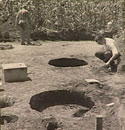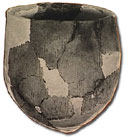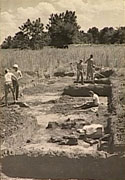
 |
| Prehistoric
People |
|
The Council Grove area was inhabited by
people eight to ten thousand years ago. Little is known of the
life ways of these "Paleo-Indian" people, although the
findings of archeologists reveal some general conclusions as to
how they lived. These early people were hunter-gatherers who
lived on bison and mammoth meat, fish, mollusks, and
miscellaneous smaller mammals. This diet would have been
supplemented by seeds, nuts, and berries. The size of these
groups of natives may have been twenty-five to thirty. They were
probably nomadic.
|
The people of the Archaic period, which extended from eight
thousand to two thousand years ago, lived in an environment
considerably warmer and drier than the Paleo-Indians.
Populations levels in the Flint Hills appear to have declined
significantly during this period. A variety of tools were
produced from raw materials including awls, punches, knives, and
scrapers. During this period the Archaic people learned to make
projectile points by fire-forging chert, which was in abundant
supply in this area.
|

|
 |
A major archeological dig conducted in
1962 and 1964 by the Kansas Historical Society unearthed
an Archaic-period camp site located a few miles north of Council
Grove. The location, known as the William Young Site, appears to
have been inhabited as early as 5,500 years ago. It provided
cultural evidence ranging from the surface to as deep as seven
feet. Archeologists uncovered burned stone hearths, shallow
pits, and a few postholes. Stone artifacts were abundant.
Points, knives, axes and gouges were recovered here along with
two ceramic effigy heads.
|
|
About two thousand years ago, Hopewellian
Indians, characteristic of eastern woodland tribes, moved into
the region near present-day northeast Kansas. The Hopewellians
brought domesticated plants, primitive agriculture, and
ceramic-making with them. Long-distance trade was also a feature
of this group.
|
 |
 |
From 500 to 1,000 years ago the natives in
the region were evolving into the central-plains tradition. The
Central Plains Indians increased their use of agriculture and
developed scattered farmsteads, small hamlets, and villages.
Their dwellings were built on terraces overlooking rivers and
streams. These people evolved into the first distinguishable
tribes to inhabit Kansas. The Pawnees to the north and the
Wichita to the south lived in Kansas one thousand years ago.
They tended gardens, raising squash, beans, and corn, and hunted
bison during two major hunts each year.
|
|
Trade with other regions was a common
characteristic of these prehistoric inhabitants, although the
frequency and extent of trade varied with each cultural group.
There is little doubt that prehistoric Indians had for centuries
used a trade route to the Southwest which in 1821 became the
Euro-American Santa Fe Trail. And given the abundance of wood,
water, grass, and game here, Council Grove had been a favorite
campsite for the Indians long before white people arrived.
|
 |
|
|


